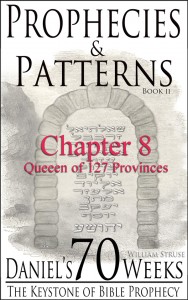 “Now it came to pass in the days of Ahasuerus, (this is Ahasuerus which reigned, from India even unto Ethiopia, over an hundred and seven and twenty provinces:) . . .” Esther 1:1
“Now it came to pass in the days of Ahasuerus, (this is Ahasuerus which reigned, from India even unto Ethiopia, over an hundred and seven and twenty provinces:) . . .” Esther 1:1
To me one of the coolest statements in the book of Nehemiah is an often overlooked mention of the queen of Persia. It’s a statement that frankly seems out of place unless you understand the chronological context of the Persian era. In the past few chapters, we’ve learned that the Jewish people were shown amazing favor during the reign of Darius ‘the Great’ Artaxerxes. This king over 127 provinces went out of his way to financially support and encourage the construction of the temple of Jerusalem as well as the city itself. It turns out there is more to the story than most of us have realized, and the book of Nehemiah gives us a clue:
And it came to pass in the month Nisan, in the twentieth year of Artaxerxes the king, that wine was before him: and I took up the wine, and gave it unto the king . . . And the king said unto me, (the queen also sitting by him,) For how long shall thy journey be? and when wilt thou return? So it pleased the king to send me; and I set him a time. (Nehemiah 2:1–6, emphasis mine)
Kind of curious, isn’t it? Why do you think Nehemiah saw fit to include this seemingly irrelevant information about the queen of Persia? Why would his Jewish readers care about Artaxerxes’s Gentile queen? Well, this apparently trivial fact gives us a glimpse into the internal affairs of Darius ‘the Great’ Artaxerxes during the early years of his reign. The most likely reason the queen of Persia would be mentioned by Nehemiah is that his audience understood who he was referring to. As we will see, Nehemiah mentioned the queen of Persia because this was none other than the Jewish heroine Hadassah, or as she is commonly known, Esther. If you are skeptical, that’s understandable—many respected biblical scholars have claimed that Esther was the queen of the Persian king Xerxes I, Darius the Great’s successor. In the book of Esther itself he is merely called “Ahasuerus.” But what does the biblical record say?
As we learned in the past several chapters, the Bible provides reasonable if not conclusive evidence that Darius ‘the Great’ was also called Artaxerxes and that it was during his reign that the events of Ezra and Nehemiah took place. So here we find Nehemiah, cupbearer to Darius ‘the Great’ Artaxerxes, asking the king for permission to return to Jerusalem and rebuild its walls. The text also informs us that the queen was present at this audience.
Artaxerxes = Ahasuerus?
Some might understandably challenge the notion that the Artaxerxes of Nehemiah is the same as the Ahasuerus of the book of Esther, but let’s withhold judgment until we’ve looked at all of the evidence.
First, it is important to once again note that “Ahasuerus” is a title given to Persian kings, much like the title “Artaxerxes.” As we saw in chapter 3, the Bible identifies Cyrus’s son Cambyses with the title of Ahasuerus, and Daniel 9 identifies a Darius “of the seed of the Medes” as the son of an Ahasuerus. Including the reference in Daniel 9, we have at least three Medes or Persians whom the Bible identifies with this title. The ISBE Bible Dictionary entry 297 explains:
297 Ahasuerus or Asseurus
<a-haz-u-e’-rus>, (Septuagint Grk: Assoueros, but in Tobit 14:15 Asueros; the Latin form of the Hebrew Heb: ‘achashwerosh, a name better known in its ordinary Greek form of Xerxes): It was the name of two, or perhaps of three kings mentioned in the canonical, or apocryphal, books of the Old Testament.
With this evidence in mind, neither Artaxerxes nor Ahasuerus should be understood as proper names, and as such they provide us little basis upon which to determine the identity of the Persian kings being mentioned in the biblical passages. As we have done with Ezra and Nehemiah, we will rely on the Bible’s internal chronological evidence as well as other circumstantial details to make our determinations.
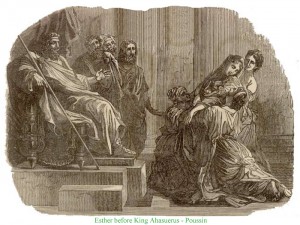 Back to Shushan the Palace
Back to Shushan the Palace
In our efforts to determine the identity of the Persian Ahasuerus spoken of here in Nehemiah, let’s turn our attention to the location of these events. Nehemiah 1:1 and Esther 1:1–2 provide the details on Shushan, the palace of the Persian kings.
The words of Nehemiah the son of Hachaliah. And it came to pass in the month Chisleu, in the twentieth year, as I was in Shushan the palace . . . (Nehemiah 1:1, emphasis mine)
Now it came to pass in the days of Ahasuerus, (this is Ahasuerus which reigned, from India even unto Ethiopia, over an hundred and seven and twenty provinces:) that in those days, when the king Ahasuerus sat on the throne of his kingdom, which was in Shushan the palace . . . (Esther 1:1–2, emphasis mine)
The above verses allow us to conclude that both events took place in the same location. But is the Artaxerxes of Nehemiah the same as the Ahasuerus of Esther? Take a look at the following biblical and secular sources and see what you think:
Now it came to pass in the days of Ahasuerus, (this is Ahasuerus which reigned, from India even unto Ethiopia, over an hundred and seven and twenty provinces) . . . (Esther 1:1 LXE, emphasis mine)
Now when Darius reigned, he made a great feast unto all his subjects, and unto all his household, and unto all the princes of Media and Persia, and to all the governors and captains and lieutenants that were under him, from India unto Ethiopia, of an hundred twenty and seven provinces. (1 Esdras 3:1 KJA, emphasis mine)
The great king Artexerxes unto the princes and governors of an hundred and seven and twenty provinces from India unto Ethiopia, and unto all our faithful subjects, greeting. (Ester 16:1 KJA (Greek), emphasis mine)
In the second year of the reign of Artaxerxes the great king, on the first day of Nisan, Mardochaeus the son of Jairus, the son of Semeias, the son of Chisaeus, of the tribe of Benjamin, a Jew dwelling in the city Susa, a grat [sic] man, serving in the king’s palace, saw a vision. Now he was of the captivity which Nabuchodonosor king of Babylon had carried captive from Jerusalem, with Jechonias the king of Judea. (Esther 1:1 LXE, emphasis mine)
In the fourth year of the reign of Ptolemeus and Cleopatra, Dositheus, who said he was a priest and Levite, and Ptolemeus his son, brought this epistle of Phurim, which they said was the same, and that Lysimachus the son of Ptolemeus, that was in Jerusalem, had interpreted it. In the second year of the reign of Artexerxes the great, in the first day of the month Nisan, Mardocheus the son of Jairus, the son of Semei, the son of Cisai, of the tribe of Benjamin, had a dream. (Ester 1:1–2 KJA (Greek), emphasis mine)
And the king levied a tax upon his kingdom both by land and sea. And as for his strength and valour, and the wealth and glory of his kingdom, behold they are written in the book of the Persians and Medes, for a memorial. And Mardochaeus was vicery to king Artaxerxes and was a great man in the kingdom, and honored by the Jews, and passed his life beloved of his nation. (Esther 10:1 LXE , emphasis mine)
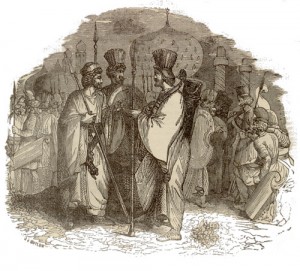 Now, in the first year of the king’s reign, Darius feasted those who were about him, and those born in his house, with the rulers of the Medes, and princes of the Persians, and the toparches of India and Ethiopia, and the generals of the armies, of his hundred and twenty-seven provinces (Antiquities of the Jews 11:33, emphasis mine)
Now, in the first year of the king’s reign, Darius feasted those who were about him, and those born in his house, with the rulers of the Medes, and princes of the Persians, and the toparches of India and Ethiopia, and the generals of the armies, of his hundred and twenty-seven provinces (Antiquities of the Jews 11:33, emphasis mine)
Mordecai, the Jew, in the Greek edition of Esther {Apc Est 11:1-12}, is said to have had a dream on the first day of the month of Nisan, in the second year of the reign of Artaxerxes the Great (or Ahasuerus or Darius, the son of Hystaspes), concerning a river signifying Esther and two dragons portending himself and Haman. 3484c AM, 4194 JP, 520 BC (Ussher, Annals of the World, p. 126 , section 1015, emphasis mine)
The first part of the celebration was given over to the hundred and twenty seven rulers of the hundred and twenty-seven provinces of his empire. (Louis Ginzberg, Legends of the Jews, XII “Esther—The Feast for the Grandees”)
And the elders of the Jews builded, and they prospered through the prophesying of Haggai the prophet and Zechariah the son of Iddo. And they builded, and finished it, according to the commandment of the God of Israel, and according to the commandment of Cyrus, and Darius, and [even] Artaxerxes king of Persia. (Ezra 6:14, emphasis and strikethrough mine)
Now after these things, in the reign of Artaxerxes king of Persia, Ezra the son of Seraiah . . . This Ezra went up from Babylon; and he was a ready scribe in the law of Moses, which YHWH God of Israel had given: and the king granted him all his request, according to the hand of YHWH his God upon him. (Ezra 7:1–6, emphasis mine)
The common thread of all the above references is that Darius ‘the Great’, also known as Artaxerxes or Ahasuerus, was the Persian king who ruled over 127 provinces from India to Ethiopia. This further strengthens the connection between the events at Shushan the palace as described in the book of Nehemiah and those described in the book of Esther.
But as fascinating as the above circumstantial evidence might be, we still have not provided a solid chronological basis for it. For this evidence we turn to the lineage of Mordecai as found in Esther 2:5–6:
Now in Shushan the palace there was a certain Jew, whose name was Mordecai, the son of Jair, the son of Shimei, the son of Kish, a Benjamite; who had been carried away from Jerusalem with the captivity which had been carried away with Jeconiah king of Judah, whom Nebuchadnezzar the king of Babylon had carried away. (Esther 2:5–6)
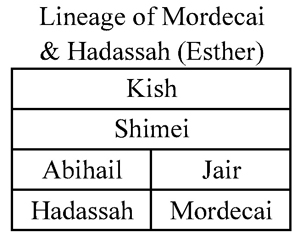 Mordecai and Hadassah
Mordecai and Hadassah
Esther 2:5–6 gives the lineage of Mordecai through his great-great-grandfather Kish. The most reasonable reading of this passage shows that Kish, the great-great grandfather of Mordecai and Esther, was taken captive by Nebuchadnezzar at the same time as King Jeconiah of Judah in approximately the eighth or ninth year of Nebuchadnezzar (see 2 Kings 24:12–16, 2 Chronicles 36:10). Chronologically, this means there were eighty years between the start of Kish’s captivity (in the ninth year of Nebuchadnezzar) and the seventh year of Darius, 115 years between the ninth year of Nebuchadnezzar and the seventh year of Xerxes I, and 136 years to the seventh year of Artaxerxes I—Longimanus. Using the most reasonable metrics, we find that in order for Esther to be a young girl or damsel (na’arah, as she is called in the Hebrew text) in the seventh year of a Persian king, the most reasonable conclusion once again points us in the direction of Darius ‘the Great’ Artaxerxes.
Some historians claim that it is Mordecai’s captivity, not Kish’s, that is in view in Esther 2:5–6, but this is not biblically plausible. As the chart above shows, Hadassah and Mordecai were of the same generation. Even if there was a great disparity in their ages, by no reasonable means could Hadassah have still been a na’arah by the reign of Darius ‘the Great’, and definitely not so by the eras of Xerxes I or Longimanus, if it was Mordecai’s captivity which was in view in the passage above. The chronology of the captivity leaves little doubt that Darius ‘the Great’ was Esther’s king.
A Generational Comparative
For visual people like myself, the following chart may help you wrap your mind around the contemporaneous relationships of Esther, Nehemiah, and Ezra and the kings of Persia, Media, Babylon, and Judah. This chart is based upon the work of Richard Edmund Tyrwhitt in his 1868 book Esther and Ahasuerus. I have modified it to include Ezra and Nehemiah as well as the high priests of Judah. For those interested in the subject of Esther and her king, I heartily recommend Tyrwhitt’s two-volume work on the subject.
The following chart is too large to reproduce on a Kindle, so the following link will take you to a higher resolution PDF image you can view or print:Generational Comparative of Esther and Her King

Darius the Huckster
A final piece of evidence regarding Darius’s place in the Second Temple era comes from the historian Herodotus, who records that Darius established a revolutionary form of tribute that allowed his subjects to provide goods or commodities in lieu of gold and silver (Herodotus iii:89). This earned Darius the somewhat ignoble title of “Huckster” from Herodotus. It is fascinating to see this confirmed in the books of Esther, Ezra, and Nehemiah. The Darius of Ezra 6 and the Darius “even” Artaxerxes of Ezra 7 did indeed provide material support to the Jewish people from the king’s treasure house in the form of commodities, not just money:
And the king Ahasuerus laid a tribute upon the land, and upon the isles of the sea. (Esther 10:1)
Then Darius the king made a decree . . . Moreover I make a decree what ye shall do to the elders of these Jews for the building of this house of God: that of the king’s goods, even of the tribute beyond the river, forthwith expenses be given unto these men . . . And that which they have need of, both young bullocks, and rams, and lambs, for the burnt offerings of the God of heaven, wheat, salt, wine, and oil, according to the appointment of the priests which are at Jerusalem, let it be given them day by day without fail. (Ezra 6:1–9, emphasis mine)
Now after these things, in the reign of Artaxerxes king of Persia, Ezra the son of Seraiah . . . This Ezra went up from Babylon . . . And whatsoever more shall be needful for the house of thy God, which thou shalt have occasion to bestow, bestow it out of the king’s treasure house. And I, even I Artaxerxes the king, do make a decree to all the treasurers which are beyond the river, that whatsoever Ezra the priest, the scribe of the law of the God of heaven, shall require of you, it be done speedily, unto an hundred talents of silver, and to an hundred measures of wheat, and to an hundred baths of wine, and to an hundred baths of oil, and salt without prescribing how much. (Ezra 7:1–6, 7:20–22, emphasis mine)
The Power of Persia
At the height of Persian power and influence, Darius ‘the Great’ Artaxerxes ruled over 127 provinces, and Hadassah (Esther) became his queen. Think about the implications of this information! During the reign of Darius ‘the Great’, a young Jewish woman was queen. Mordecai, Hadassah’s cousin, was the second most powerful man in Persia. Nehemiah was cupbearer. Josephus even notes that Zerubbabel, who preceded Nehemiah as governor of Jerusalem, was a bodyguard to the king. This whole picture explains in part the magnanimity of Darius toward the Judean captives’ efforts in rebuilding their temple and city. These very same people were some of his most trusted and loyal subjects.
As a side note, Haman’s Agagite lineage—a people group with a history of bad blood with the Jews—is often pointed to when explaining his seemingly unjustified hatred of the Jewish people. Now you know the rest of the story. Haman was a power-hungry man, and the Jewish people were clearly a threat to his plans during the rise of Darius ‘the Great’ to the pinnacle of Persian power and influence.
The following chart provides a chronological timeline of the events found in the books of Ezra, Nehemiah, and Esther as we’ve explored in the past few chapters. As you look at the timeline, consider the impact Hadassah’s efforts had in protecting her brethren throughout the Persian empire. Had she not acted as she did, Ezra, the Judean repatriates, and the very Second Temple itself might have become victims of Haman’s evil machinations.
Persia and the Coming Messiah
It’s fascinating to me to see how YHWH used a secular nation like Persia to play such an important role in the history of the Jewish people. Persia at the height of its power was used by YHWH to restore His people to the land of Israel and rebuild His desolate sanctuary. It is intriguing to note that Britain was the world power of our generation which brought about the return of the Jewish people to the land of Israel after nearly two thousand years of desolations. Even more fascinating, it is the US (once a subject of British rule) that has now taken the mantle of leadership on the world stage, and indeed, our very own government has inserted itself into the current affairs concerning the Jewish people and Jerusalem. Watch in coming years for the world powers involving themselves in the affairs of the Jewish people, Jerusalem, and the Third Temple. As Mark Twain is quoted as saying, “History doesn’t repeat itself, but it does rhyme.”
Though the events described in the past few chapters were incredibly important to understanding the four Persian commandments to restore and build Jerusalem, our quest to find the starting point to the countdown to the Messiah is not finished. None of those four Persian decrees totally satisfied the contextual criteria of the “word to return and build Jerusalem” of Daniel 9:25. As I have said, there must be a decree we are overlooking—and indeed, there is. The final decree or commandment we will look at is in fact the focal point of all these events, and yet it has been all but ignored by biblical scholars. What I’m talking about is the little known fifth decree to return and restore.

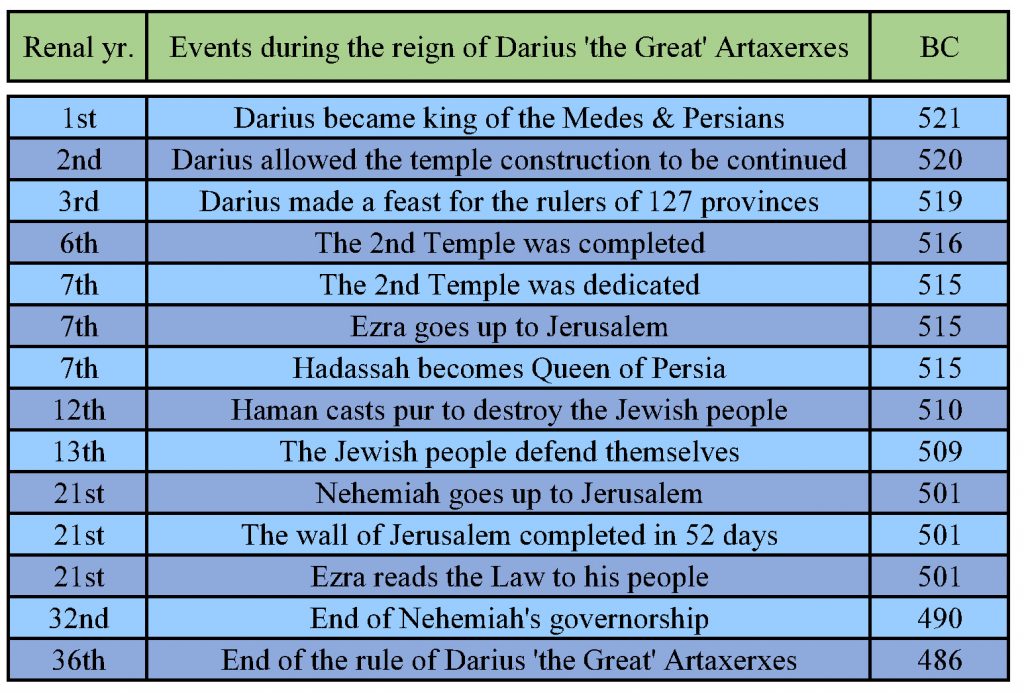



Pingback: The Jewish Queen of Persia | The 13th Enumeration
Esther became queen 569 BC.
“The seventh year of Darius I is 514 BC; this date would make Esther eighty-five years old if she was a baby in the deportation of 599 BC. Esther would not have won a beauty contest at this age.”
Good morning Lawrence,
I would respectfully disagree. Please see my article Queen of 127 Provinces for more details.
Regards,
William
Hi William,
As you can see I disagree with Chabad Chronology also.
I am just repeating Gene’s Chronology.
I have studied it a fair amount. I have never found anybody, who has studied it, give a reasoned disagreement.
Thanks for attention to Esther, Purim, Bible Chronology and for posting.
Lawrence
I’ve been researching this – so it was wonderful to find someone who had already put many of the sources I was looking at together! Here are my only questions. And bear with me, becasue I’ve only been researching for a few days and the Achaemenid empire is not my strong-suit. Is Darius the Great the only one who held unto the 127 provinces? Did Xerxes I loose them? Also, you use 1 Esdras to demonstrate the large feast that Darius held. Is there a chance that large feasts of that nature been held by later kings?
Also, in your opinion, is it helpful to try to do on a search for the historical Vashti and Esther? Becasue I’ve been trying to, and I’m found some rabbit trails – but nothing obvious.
Also, another thing that I would like to soundboard off you: the book of Daniel mentions “Astyages” death and that he was succeeded by Cyrus (Greek, Daniel 12:1). But according to your research, Cyrus is “Astyages”. Any thoughts?
Thanks again, for posting this. This will make my primary source research go much faster! I have to look at your Mordecai chart longer – becasue I’m getting a headache trying to work it out.
Pingback: The Revealed, Providential God | perSpectives 12